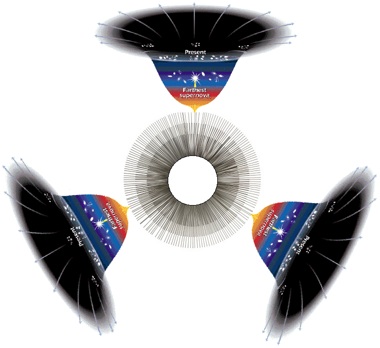
In this image:
Roger Penrose, in his book The Emperor's New Mind (Oxford 1989, pages 316-317) said:

In this image:
Penrose (in his book The Emperor's New Mind (Oxford 1989, page 339)) proposed that the solution of his Puzzle might be related to Weyl Curvature, saying "... For some reason, the universe was created in a very special (low entropy) state, with something like the WEYL = 0 constraint of the FRW-models imposed upon it ...".
Here is how such a WEYL = 0 constraint may be related to the low entropy due to a Many-Worlds decoherence "collapse" at the end of Zizzi's Inflation:
From the book The Dawning of Gauge Theory, by O'Raifeartaigh (Princeton 1997, pages 45,77-81,86,120,144):
"... Weyl's ... 1918 paper ... showed how a geometrical significance could be ascribed to the electromagnetic field ... in 1922 ... Shroedinger ... suggested ... the flaw in the original Weyl theory might be removed by quantum mechanics ... the exponent of the non-integrable Weyl factor became quantized ...... London in his 1927 paper ... establish[ed] the relation between Weyl's non-integrable scale factor and the gauge principle as it ocurs in the Hamilton-Jacobi, de Broglie and Schroedinger equations ... it is the complex amplitude of the de Broglie wave ... The fault in Weyl's original theory lay not in the presence of Weyl's non-integrable scale-factor but in the fact that it was real and applied to the metric. It should be converted to a phase-factor and applied to the wave-function. ... Weyl's reaction ... was ... enthusiasm ... in ... 1929 ... electromagnetism is an accompanying phenomenon of the material wave-field and not of gravitation ...
... Pauli proceeded to incorporate many of Weyl's ideas into his Handbuch article and by 1953 he had become an ardent proponent of the gauge principle ...".
In the early 1950s, Bohm developed his theory, an elaboration of de Broglie-Schroedinger quantum theory.
From B. G. Sidharth's paper at physics/0211012:
"... Santamato ... Phys.Rev.D. 29 (2), 216ff, 1984 ... J. Math. Phys. 26 (8), 2477ff, 1984 ... Phys.Rev.D 32 (10), 2615ff, 1985 ... further developed the deBroglie-Bohm formulation by relating the ... Quantum potential to ... Weyl's geometry ...".
From The Anthropic Cosmological Principle, by Barrow and Tipler (Oxford 1986, pages 446-447):
"... Penrose ... suggested that the Weyl curvature could be intimately related to the gravitational entropy of space-time ... Unfortunately, as yet there is no obvous candidate to use as a gravitational entropy Sg ...".
As Penrose said in his book The Emperor's New Mind (Oxford 1989, pages 210-211):
"... REIMANN = WEYL + RICCI ... Einstein's equations become ... RICCI = ENERGY ...The Weyl tensor WEYL measures a tidal distortion of our sphere of freely falling particles (i.e., an initial change in shape, rather than in size), and the Ricci tensor RICCI measures its initial change in volume. ... the Weyl tensor ... is an important quantity. The tidal effect that is experienced in empty space is entirely due to WEYL. ... there are differential equations connecting WEYL with ENERGY, rather like the Maxwell equations ... a fruitful point of view is to regard WEYL as a kind of gravitational analogue of the electromagnetic field quantity ...".
These remarks of Penrose seem to me to justify seeing the Weyl curvature as a Weyl gauge quantum phase for a Bohm-type Quantum Potential, especially in view of my model in which the Bohm-type Quantum Potential comes from what is commonly viewed as a gravitational part of Bosonic String Theory and in which Many-Worlds gravitational superposition separation plays a fundamental role in Quantum Consciousness.
since Deutsch has indicated that the Bohm potential can be seen to be equivalent to Many-Worlds Quantum theory,
it seems to me that
the Weyl-Schroedinger-London-Santamato description of the Quantum potential in terms of Weyl curvature could be seen as Penrose's Weyl curvature entropy.
Moreover,
and
the unification of RICCI for gravity and WEYL for quantum potential indicate to me that Jack Sarfatti's idea that BOTH should have back-reaction is correct.
......